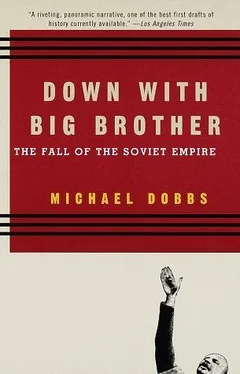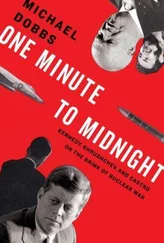“The air navigation light is on; the flashing light is on,” he radioed back.
“Flash the interceptor’s lights as a warning signal,” ordered Kornukov. “Order him to approach the target, rock wings at it, and force it to land.” To still the hubbub that was coming in over his headset, he gave another order to the commander of Osipovich’s squadron: “Stop that horsing around at the command post. Only you, I, and the controller are to talk. No one else.” 9
Positioned behind and slightly below the intruder plane, Osipovich fired four bursts of armor-piercing shells, 243 rounds in all. In response, the target appeared to reduce speed, forcing Osipovich’s Su-15 to shoot ahead. Both planes had now crossed the island from east to west—a twelve-minute flight—and were heading out into the Sea of Japan. In the thick moon haze of the predawn sky, it seemed to Osipovich that the target was taking evasive action. He knew that if he slowed down, he would stall. So he dived two thousand feet and banked around for a second run at the intruder. His thoughts were consumed by the flashing lights of his instrument panel. 10
THE 240 PASSENGERS on board Korean Airlines flight 007 from Anchorage to Seoul were oblivious of the drama just outside their portholes. Some had covered themselves in blankets and had drowsed off. Others were waiting for the cabin crew to come around with breakfast as the plane flew over Japan on its approach to South Korea. Most of the window shades were down, for the in-flight movie. Up on the flight deck the crew were suppressing yawns and engaged in desultory conversation about vacations and customs procedures. The talk turned to the location of the airport currency exchange.
“What kind of money do you wish to exchange?” asked one crew member. “Dollar to Korean money is all right.”
“Yes.”
“That is in the domestic building.”
“It could be open nine o’clock in the morning. It could be ten o’clock.” 11It did not occur to Captain Chun Byung-in and his colleagues that they had flown in and out of Soviet airspace for more than two hours and were being tracked by Soviet interceptors. Shortly after leaving Anchorage, they had programmed the well-trodden route to Seoul into the Boeing’s computer. At this moment they believed themselves to be more than two hundred miles to the east, in international airspace, off the coast of Japan. But a tragic error had occurred. Instead of following the recognized route, the plane had followed a constant magnetic heading that had brought it right over Soviet territory. The onboard inertial navigation system had failed to engage, either because the pilots had switched it on too late or because someone had flipped the switch to the wrong position. There had been many opportunities to catch the error, but the flight was long and tedious, and nobody noticed that the plane was drifting off its assigned route. 12
At the moment when Osipovich was attempting to attract his attention with a burst of cannon fire, Captain Chun was talking to air traffic control in Tokyo. He received permission to climb two thousand feet to an altitude of thirty-seven thousand feet, a routine fuel-saving maneuver at this point in the flight. Osipovich interpreted the climb as an attempt to escape.
BY NOW THE INTRUDER PLANE was heading out of Soviet airspace, and the generals down on the ground were beginning to panic. If it got away, they would be accused of dereliction of duty and could face dismissal. There was no time left to identify the target positively. Osipovich was running out of fuel. He had no more than ten to fifteen minutes’ flying time remaining. In theory he could have tried to communicate with the intruder aircraft on the internationally recognized 121.5 megahertz emergency frequency. But that would have meant retuning his radio and losing contact with his ground controllers. There was no time for that either. 13
At 6:21, just as dawn was breaking over the island of Sakhalin and KAL 007 was flying out of Soviet airspace, Kornukov made his final decision. The air crackled with commands.
“Fire missiles, fire on target six-zero-six-five, destroy target six-zero-six-five.”
“Get Osipovich to fire, and soon!”
“Carry out the task, destroy!”
“Bring one-six-three in behind Osipovich to guarantee destruction!”
“Eight-zero-five, approach target and destroy target!”
As he spun around behind the Boeing, Osipovich had only one thought in his mind: to down the enemy plane. He had even dreamed of such a moment. This would be the culmination of his career as a Soviet interceptor pilot. He stubbed his index finger to release the heat-seeking missile. Two seconds later he fired the radar-guided missile.
“Launch executed,” he radioed back.
It took the missiles roughly thirty seconds to cover the five miles between the two planes. Then Osipovich saw a burst of yellow flame from the tail section. The navigation lights went out immediately. At first the plane seemed to climb. But as he peeled off to the right, he could see the intruder plane plummeting toward the sea.
“The target is destroyed,” he announced excitedly. 14
THE KREMLIN
September 2, 1983
THE DESTRUCTION of Korean Airlines flight 007 was a spectacular example of what the historian Barbara Tuchman has described as the “March of Folly,” action that flies in the face of national self-interest. By shooting 269 innocent people out of the sky, the Soviets seemed to confirm the “evil empire” tag that had been stuck on them by President Reagan.
Soviet leaders compounded the public relations disaster of shooting down a civilian aircraft by refusing—for almost a week—to acknowledge what they had done. The first statement by the official Tass news agency about the incident failed to mention any shots. It claimed that an unidentified aircraft, flying “without navigation lights,” had violated Soviet airspace. Soviet interceptors had attempted to guide the plane to the “nearest airfield,” but the intruder had ignored all the “signals and warnings” and “continued its flight in the direction of the Sea of Japan.” These claims were a gift to conservatives in the United States, who had no illusions about Moscow’s willingness “to lie and to cheat,” in Reagan’s phrase. Soviet responsibility for the shootdown was easily demonstrated. The Americans simply played a tape of the exchanges between Sakhalin ground control and the interceptor pilot to a hushed session of the UN Security Council.
No single individual was to blame for this self-inflicted disaster. It reflected the collective woodenheadedness of a system that had sidetracked Russia into decades of self-imposed isolation, a system that suppressed dissenting opinions and was unable to deal flexibly with new challenges, a system that prized ideology over common sense. It was the same woodenheadedness that had caused Kremlin leaders to murder millions of their own citizens in the name of progress, to devastate their country’s natural environment for short-term economic gain, to persecute its most outstanding writers and scientists, and to stumble into an unpopular, unwinnable war in Afghanistan despite numerous warnings about the risks of such an enterprise. The system was so powerful, and so well entrenched, that it seemed to paralyze virtually all who lived in its shadow.
LESS THAN TEN MONTHS had passed since Brezhnev’s death, but they had taken their toll on Yuri Andropov. Worn down by rapidly failing health and awesome responsibilities, the new Soviet leader looked like a skeleton. Even longtime associates had difficulty recognizing him. He spent much of his time in a hospital room, cluttered with medical equipment and Kremlin telephones, sitting in an ancient dentist’s chair with a high headrest that allowed him to shift his position at the press of a button. In the summer of 1983 his kidneys had given out entirely, and he had to be hooked up to a dialysis machine twice a week. 15For the Soviet people the general secretary had become a kind of ghostly presence that could be felt and sensed but was never seen. If he needed to communicate with the nation, he did so in written form, through a statement “from the Soviet leadership,” or a Tass communiqué, or perhaps an interview in Pravda .
Читать дальше












